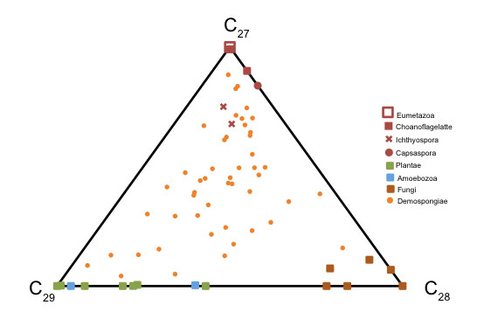2012 Annual Science Report
 Massachusetts Institute of Technology
Reporting | SEP 2011 – AUG 2012
Massachusetts Institute of Technology
Reporting | SEP 2011 – AUG 2012
Geochemical Signatures of Multicellular Life
Project Summary
Sterols are essential membrane components of eukaryotes but their structural diversity varies across different eukaryotic lineages. Our research aimed to determine if are any systematic variations in sterol structures between Metazoa and their immediate unicellular relatives. We found that there is a stepwise reduction in production of 24-alkyl sterol on the path toward eumetazoa suggesting an evolutionary preference for C27 sterols among animals and their kin. A major exception to this finding are the Demosponges which produce a structurally diverse array of sterols.
We also completed a study of sediments and oils in the South Oman Salt Basin that reported an array of unusual hydrocarbon patterns that are likely to be biosignatures for early metazoa.
Project Progress
Sterols are essential membrane components of eukaryotes, but their structural diversity varies across different eukaryotic lineages. It is presently unclear if there are any systematic variations in sterol structures between Metazoa and their unicellular relatives. To investigate sterol biosynthesis in these organisms we integrated natural product chemistry and genomics to identify in parallel the suites of sterols produced and the biosynthetic network that produced them. This allows us to view changes in sterol composition both at the biochemical and evolutionary level. We analyzed basal metazoans and their unicellular relatives. The unicellular organisms in this study are from the eukaryotic supergroup Opisthokonta including the free-living choanoflagellate Salpingoeca rosetta, the symbiotic filose amoeboid Capsaspora owczarzaki, and two symbiotic Ichthyosporeans. For comparison we also analyzed the sterols from two basal Metazoa from the phyla Porifera and Ctenophora. Sterols were identified by gas chromatography and mass spectrometry. The choanoflagellate sterols were similar to those in previous reports including three C27 compounds with 2, 3 and 4 double bonds and one C28 compound with three double bonds. Ichthyosporeans are dominated by C27 Δ5, 24 but also produce cholesterol, three C28 sterols and two 4-methyl C27 sterols. Capsaspora produce cholesterol, a tetraunsaturated C27 and two C28 sterols. The poriferan and ctenophore sterol fractions were dominated by cholesterol. Putative biosynthetic pathways were reconstructed from available genomes of these organisms along with a wide taxonomic selection of eukaryotic genomes. We find a stepwise reduction in methylated sterol production on the path toward eumetazoa suggesting an evolutionary preference for C27 sterols among Metazoa and their kin. A major exception to this finding are the Demosponges which produce a structurally diverse array of sterols.
In related work completed during the year we published a study of hydrocarbon molecular fossils preserved in Ediacaran-Cambrian rocks of the South Oman Salt Basin. We found steroids derived from sponges, a new C19 steroid of unknown origin and a branched alkane that resembles those found in the cuticular waxes of insects.
Metazoa and their unicellular relatives produce predominantly C27 sterols. This is presumably driven by an underlying biological preference for cholesterol over side chain methylated sterols. We observe a stepwise change in sterol composition among the unicellular Opisthokonts which follows time of divergence where early branching groups produce more C28 sterol and later groups produce more C27. The end member eumetazoans produce exclusively C27 sterols. One major exception to this are the Demospongiae (Porifera) which produce a massive array of sterols ranging from C26 to C31. The biochemical and molecular basis for this feature of sponge biochemistry is at present a mystery. Some have postulated an ecological role for sponge sterol diversity.
Publications
-
Grosjean, E., Love, G. D., Kelly, A. E., Taylor, P. N., & Summons, R. E. (2012). Geochemical evidence for an Early Cambrian origin of the ‘Q’ oils and some condensates from north Oman. Organic Geochemistry, 45, 77–90. doi:10.1016/j.orggeochem.2011.12.006
- Copley, S.D. & Summons, R.E. (2012, in Press). Terran Metabolism: The First Billion Years. In: Impey, C., Lunine, J. & José Funes, J. (Eds.). Frontiers of Astrobiology. Cambridge University Press.
- Summons, R.E. & Lincoln, S.A. (2012). Biomarkers: Informative Molecules for Studies in Geobiology. In: Knoll, A.H., Canfield, D.E. & Konhauser, K.O. (Eds.). Fundamentals of Geobiology. Blackwell Publishing Ltd.
-
PROJECT INVESTIGATORS:
-
PROJECT MEMBERS:
Emmanuelle Grosjean
Collaborator
Gordon Love
Collaborator
Amy Kelly
Doctoral Student
Jonathan Grabenstatter
Graduate Student
-
RELATED OBJECTIVES:
Objective 4.2
Production of complex life.
Objective 5.1
Environment-dependent, molecular evolution in microorganisms

